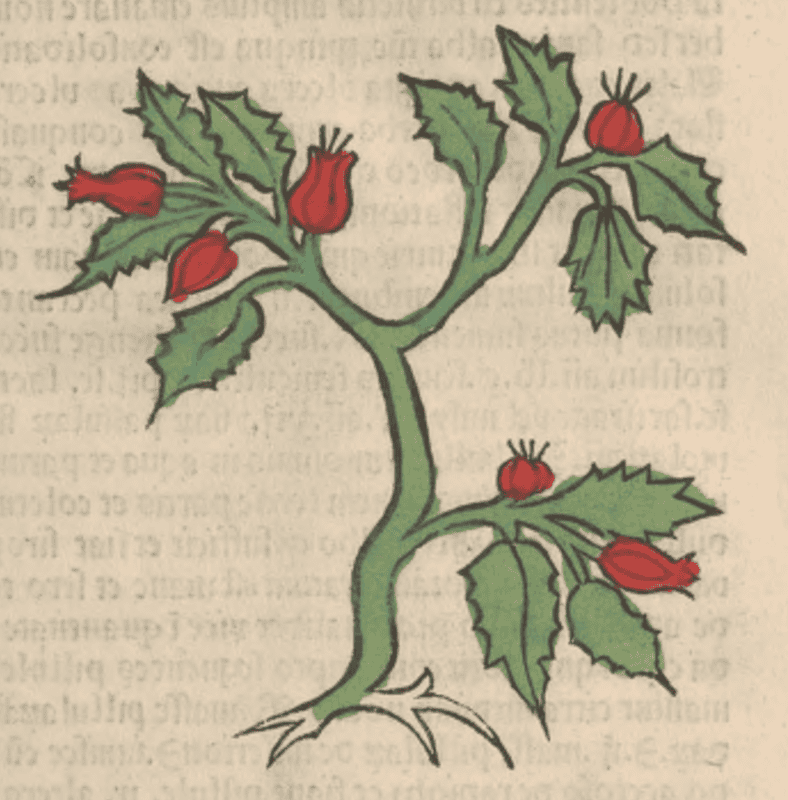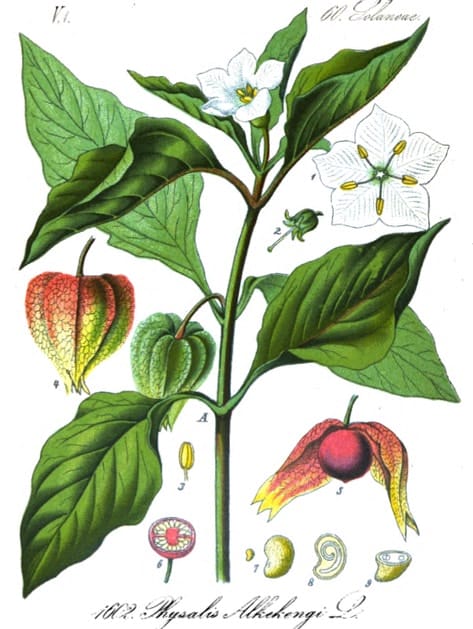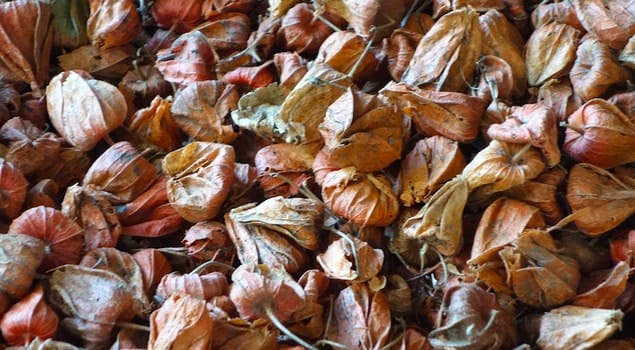Physalis, Winter CherryAlkekengi, Halicacabus, CardispermumKaknaj, Habul Kaknaj, Kakenj (Unani) Suan Jiang (TCM) |

|
 Gart der Gesundheit, Cuba, 1485
Gart der Gesundheit, Cuba, 1485 |
 Herbarius latinus, Petri, 1485
Herbarius latinus, Petri, 1485 |
 Flora von Deutschland (16), Kohler, 1884
Flora von Deutschland (16), Kohler, 1884 Winter Cherry at the Urumqi Market, Xinjiang, China (Adam, 2017)
Winter Cherry at the Urumqi Market, Xinjiang, China (Adam, 2017)Botanical name:
Physalis alkekengi
P. alkekengi var. francheti and P. pubescens of TCM are used similarly
The related P. minima and P. minima var. indica are also used in Unani.
Parts used:
Fruit; herb and root less commonly
Temperature & Taste:
Cool, dry. Bitter, Sour
“Cold and dry in the second degree” (Avicenna)
Classifications:
3E. DIURETIC. 3F. LITHONTRIPTIC. 3Q. ANTHELMINTIC
4g. HEPATIC
Uses:
1. Clears Heat and Damp, Resolves Stones, Promotes Urine:
-Edema, Stopped, Difficult, Dribbling or Burning Urine.
-Foul and Bloody Urine; Ulcers or Abscesses of the Urinary system.
-Dysuria (Chinese Pharmacopoeia)
-Regarded as specific for Gravel and Stones; said to help dissolve Stones, and passes the matter off as Gravel.
-“It is also useful in Urinary Ulcers” (Avicenna)
2. Benefits the Kidneys:
-chronic Kidney weakness; Diabetes.
-Joint pain, Arthritis and Rheumatism.
3. Moves the Blood, Clears Stasis:
-traditionally for congealed Blood
-Scrofula, Lymphadenitis.
4. Clears Heat, Stops Cough:
-heat-type Cough with yellow phlegm, Sore Throat, Hoarseness (Chinese Pharmacopoeia)
-Hemoptysis.
-“Useful in cases of Asthma” (Avicenna)
5. Clears Heat of the Stomach and Liver:
-cleanses the Liver, Jaundice (Matthiolus); also for Jaundice in TCM (Su Song)
-Liver debility and to correct Liver function (Unani)
-burning sensation in the Stomach
-adjunct to help cleanse Blood in skin diseases
-Dysentery
-“It is also used in Jaundice” (Avicenna)
6. Moves the Blood, Promotes Labor:
-Seed promotes Delivery (Shen Nong Ban Cao)
-In Unani, the fruit is used for a period following menstruation to prevent Conception.
7. Kills Worms:
-listed as Anthelmintic in older Herbals
8. Externally:
-fresh leaves applied to Inflammations, pemphigus and eczema. (TCM, Unani)
-paste of the berries resolve hard swellings and inflammations. (Unani)
-applied over Ulcers and Chronic Wounds.
-“It removes hardness of Fistula and chronic Ulcers of the ear.” (Avicenna)
Dose:
1. According to TCM sources, the Fruit, Seed, Seedling and Herb have similar functions.
10–20 fruits per day
Dried Fruit in decoction: 6–9 grams, up to 15 grams (20–40 grams fresh)
Fruit in Powder: 1–3 grams
Leaf in Decoction: 15–30 grams
Correctives:
Rose Conserve
Substitute:
1. Black Nightshade (Unani). “The plant or its leaves arc equal to Garden Nightshade in potency.” (Avicenna)
2. The Chinese Physalis Jin Deng Long is used similarly.
Main Combinations:
1. Heat-type Urinary diseases, Gravel, Stones:
i. Winter Cherry with Tragacanth, Frankincense, Pine nut, Bitter Almonds, Poppy seed, Cold Seeds, Amber (as in Troches of Winter Cherry)
ii. Winter Cherry with Cucumber seed, Dragons Blood, Tragacanth, Gum Arabic, Almond, Licorice, Frankincense, Celery seed (a version of Troches of Winter Cherry used in Uyghur medicine, called Kursi Kaknaqyi)
iii. Stones, Winter Cherry and Tribulus
2. To promote Urine:
i. Winter Cherry with Asparagus root, Fennel root, Golden Rod, decoct in water and wine (Fuller)
3. Kidney Ulcers:
i. Winter Cherry with Melon seed, Sorrel, Almond, Tragacanth, Celery seed, Fennel seed, Saffron (Unani)
ii. Winter Cherry with Tragacanth, Gum Arabic, Red Coral, Dragons Blood, Red Earth, Mastic, Melon seed, Marshmallow seed (as in Pills for Kidney and Bladder Ulcers)
4. Gout, Winter Cherry with Willow bark, Horsechestnut bark, Walnut shell, Horsetail (Meyer)
5. Acne, Boils, Eczema, Winter Cherry with Barley, Chicory, Dandelion, Fumitory, Hops, Dodder (as in Syrup of Chicory and Rhubarb)
6. Clear Heat, Ease pain and promote rest, Winter Cherry with Camomile, Violet, Poppy seed
7. Heat-type Cough, Winter Cherry with Scutellaria Huang Qin
Major Formulas:
Syrup of Chicory and Rhubarb (Nicholas)
Syrup of Senna Comp.
Troches of Winter Cherry (Trochisci Alkekengi) (Mesue)
Troches of Winter Cherry (Unani)
Electuary of Pearl (Galen)
Electuary of Scorpion (Unani)
Electuary of Seeds
Cautions:
1. Not used during Pregnancy
2. Use cautiously in marked Spleen deficiency.
3. Large doses are Narcotic
Main Preparations used:
Troches of Winter Cherry
|
‘This plant appears to be the [?] of the Greeks, which they also called [?], and the Vesicaria or Halicacabus of the Romans; it was supposed to cure diseases of the bladder. It is the Kakanah of the Persians and Kakanaj of the Arabs. It also bears the names of Kachuman, and Ardsak-pas-i-pardah, or “bride behind the curtain,” in Persia; the Sanskrit name is said to be Rajaputrika. Abu Hanifeh, author of the Book of Plants, says of Kakanaj:— “It is of the Aghahluth and is a plant resembling the Harmal (Peganum harmala), except that it is teller, with round branches, and having capsules like those of Harmal; it has also berries intensely red, like beads of cornelian, smaller than the Nabik (Zizyphus Spina-Christi) and larger than the currant, and people seek out the leaves thereof that |
have not been rendered foraminous, which leaves are then bruised and used beneficially as a dressing for maladies attended with pain.” Other names for the fruit are Jouz-el-marj and Habb-el-lahv, which indicate that they are thought to be possessed of intoxicating properties. Mahometan physicians describe it as diuretic, alterative and anthelmintic; and recommend it in skin diseases, rheumatism, jaundice and urinary affections. It is said to prevent conception if given to women after menstruation. Large doses are thought to be narcotic. Externally it is applied to promote the absorption of tumours, boils, carbuncles, &c. Laville’s gout pills consist of 15 parts of extract of Alkekengi and 5 parts of silicate of soda. Four to ten 5-grain pills are taken daily. (Pharmacographia Indica, Dymock, 1891) |
